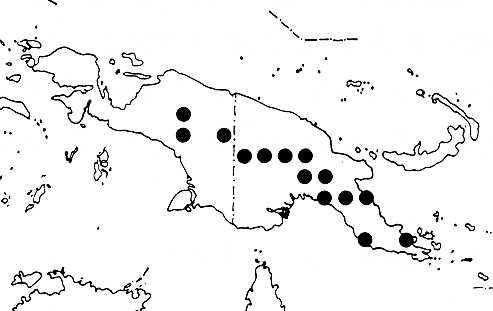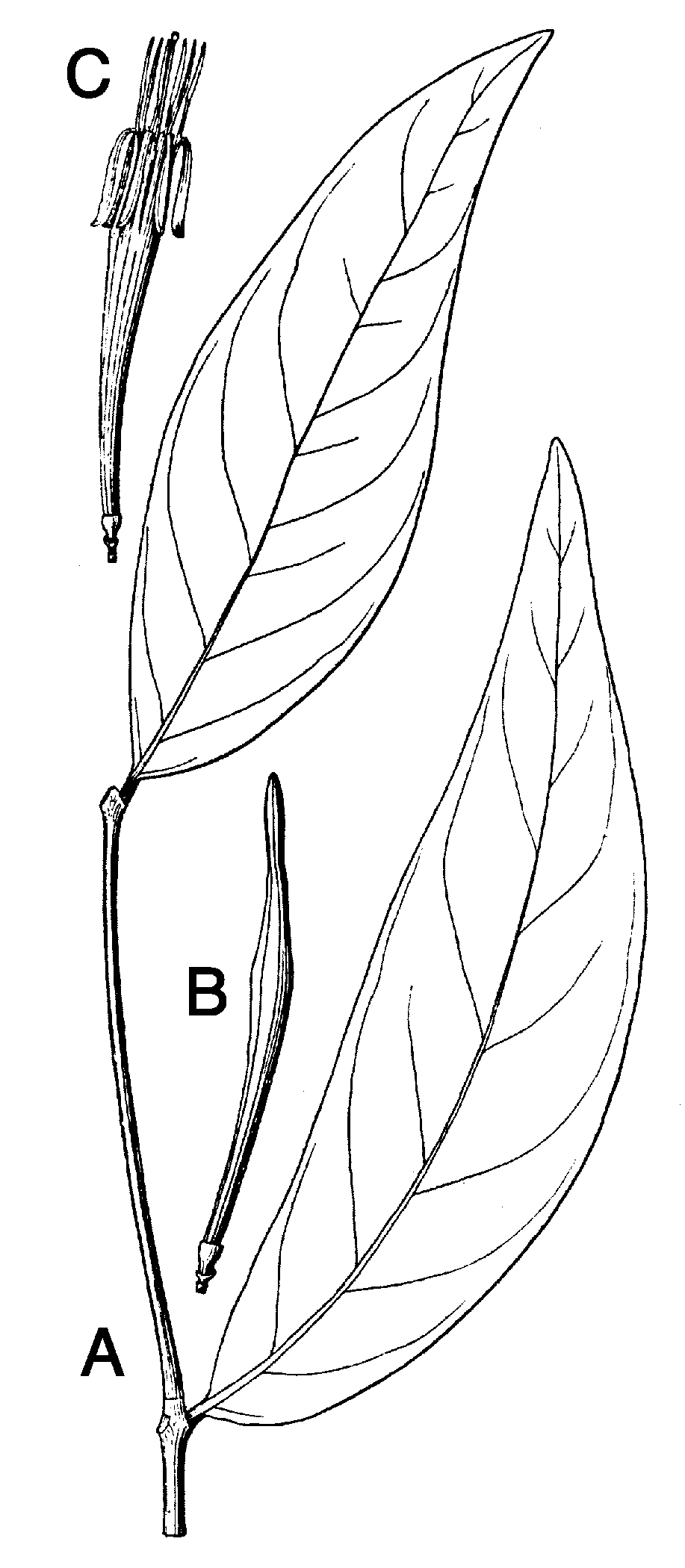
Distribution Map

Description (Barlow 1992)
Loranthus hastifolius Ridley, Trans. Linn. Soc. Bot. 9 (1916) 146. - Amyema hastifolia (Ridley) Danser, Bull. Jard. Bot. Buitenzorg III, 11 (1931) 337. - Type: Kloss s.n. (holo BM), New Guinea, Nassau Mts, 1080-1470 m, 13.ii.1913.
Doubtful species provisionally included here:
Loranthus curvifolius Krause, Bot. Jahrb. Syst. 57 (1922)
465, 490. -Amyema curvifolia (Krause) Danser, Bull. Jard.
Bot. Buitenzorg III, 10 (1929) 294. - Type: Ledermann 13077
(B, not extant), New Guinea, Felsspitze, 1400-1500 m.
For description see Danser, Bull. Jard. Bot. Buitenzorg III, 11 (1931) 337; Barlow, Austral. J. Bot. 22 (1974) 577. See also Barlow, Austral. J. Bot. 22 (1974) 574 under A. curvifolia. Along with the closely related A. finisterrae, A. hastifolia is distinct from all its congeners in its inflorescence which is a solitary flower on an articulate 'pedicel'. Amyema finisterrae can be distinguished from A. hastifolia by its smaller, more rounded, more distinctly petiolate leaves and different dimensions of the inflorescence and flower. The flower colour is described as pinkish red to dark red in the lower part and paler red or yellow above.
The species is endemic to the highlands of New Guinea (Irian Jaya),
from 1250 to 2800 m (fig. 8; 3 collections seen). Other habitat
details and hosts are unknown.
The status of A. curvifolia is doubtful. The species is
based on two collections by Ledennann from the Hunstein Mountains
of New Guinea, which were the types of Loranthus curvifolius
and L. heterochromus Krause. There appear to be no
duplicates of the types, which are no longer extant. Danser (1931)
saw the specimens, accepted the two species, and provided detailed
descriptions. Danser's descriptions generally agree with Krause's
original descriptions, although they differ in the dimensions
of some parts, notably the corollas. The two descriptions are
closely similar, and Barlow (1974) treated the two entities as
con specific under the name A. curvifolia.
In several respects the characters
of A. curvifolia, as described by Krause and Danser, agree
with those of A. hastifolia. This applies particularly
to the inflorescence, which is described and illustrated as a
solitary flower on a short articulate pedicel, inserted along
the stem internodes or on the epicortical runners. These characters
agree with those of A. hastifolia, which also occurs in
the central highlands of New Guinea and is the only species of
the genus in New Guinea with cauline inflorescences. The descriptions
differ primarily in leaf dimensions, which are much greater than
otherwise seen in A. hastifolia, and in the flowers, which
are larger and 6-merous rather than 4-merous.
If the description of A. curvifolia is not based on mixed material, then it clearly represents a very distinct and unusual species. However, the floral characters agree with those of A. squarrosa and A. seemeniana subsp. melastomifolia, and it is possible that floral fragments of one of these species had become confused with the original specimens of L. curvifolius and L. heterochromus. It may be noted that the type of L. squa"OSUS is also a Ledermann collection from the same area, and its collector's number, Ledermann 10377, is similar to that of the type of L. curvifolius, which is Ledermann 13077. Because subsequent field work in the Hunstein Mountains has yielded no additional material, the species is provisionally treated as doubtful.
For notes on inflorescence structure and biogeography, see under
A. finisterrae.
Description (Barlow 1974)
Amyema hastifolium (Ridl.) Dans. Bull. Jard. bot. Buitenz. 11: 337 (1931); Loranthus hastifolius Ridl. Trans. Linn. Soc. Bot. 9:146 (1916). Type-New Guinea, Wollaston Expedition, between Camps VII and VIII (Nassau Mts., 1080-1470 m alt.), Kloss sn., 13.ii.1913 (BM, photo in AD).
Glabrous except for the calyx and inflorescence sprinkled with large unbranched hairs. Leaves opposite; petiole c. 2 mm long; lamina elliptical to ovate, 4-7 by 2-5 cm, more or less lustrous above, dull below, contracted at the base, finely recurved at the margin, acute and somewhat acuminate at the apex; venation pennate to almost curvinerved with the midrib distinct on both sides and the lateral veins distinct above. Inflorescences axillary or on the runners, composed of a single shortly pedicel-late flower on a slender ebracteate peduncle c. 2 mm long (i.e. a flower on a jointed 'pedicel'); pedicel 0.5-1 mm long, funnel-shaped; bract conspicuous, erect, obtuse, 5 mm long. Calyx cylindrical to slightly funnel-shaped; limb truncate, 0.7 mm long. Corolla in the mature bud quadrangular, acute, c. 40 mm long, 4-merous. Anthers 5 mm long, equal to the free parts of the filaments. Stigma l.5 times as wide as the style. Fruit not seen. (Fig. 5, k-n.)
Occurrence. West Irian, from the Arfak Mts. to Lake Habbema (Fig. 6), 1250 to 2800 m altitude.
Specimens Examined. WEST IRIAN: Minjambau, Arfak Mts., 1250 m alt., Versteegh BW 12640, 20.v.1962 (L; LAE); 9 km NE. of Lake Habbema, 2750 and 2800 m alt., Brass 10802 and 10752, Oct. 1938 (CANB; L).
Amyema hastifolium is
closely related to but quite distinct from A. finisterrae,
differing from A. finisterrae in the larger, acute,
almost sessile leaves which are more strongly penninerved, the
smaller dimensions of the inflorescence (particularly the pedicel)
and longer corolla and anthers. See note under A. finisterrae.
The materials examined show that the corolla is choripetalous,
not gamopetalous as described by Danser (1931). In at least one
other case (A. seernenianurn subsp. melastomifolium)
Danser similarly interpreted partly open flowers as being
gamopetalous. See note under A. curvifoljum.
Illustrations

Unifloral inflorescence. On left, a root-borne flower. Brass 10752, L. On right, basal part of flower enlarged. Brass 10802, L. From Kuijt (1981).

Amyema hastifolium. A - portion of plant (Brass 10752). B - portion of plant (Versteegh BW 12640). C - immature inflorescence (Versteegh BW 12640). D - inflorescence (Brass 10752). From Barlow (1974).
Description (Barlow 1974) of Amyema curvifolium (Krause) Dans. Bull. Jard. bot. Buitenz. 10: 294 (1929); 11: 330, illus. Fig. 10, a-c (1931); Loranthus curvifolius Krause, Bot. Jahrb. 57: 465, 490 (1922). Type-New Guinea, Felsspitze, 1400-1500 m alt., Ledermann 13077 (B, not seen, probably destroyed).
Loranthus heterochromus Krause, Bot. Jahrb. 57: 465, 466, 490 (1922); Amyema heterochromus (Krause) Dans. Bull. Jard. bot. Buitenz. 10: 296 (1929); 11: 337, illus. Fig. 10, d-g (1931). Type-New Guinea, Felsspitze, 1400 m, Ledermann 12569 (B, not seen, probably destroyed).
Glabrous except for the inflorescence, calyx and young corolla (tomentose ?). Leaves opposite; petiole 1-8 mm long; lamina lanceolate to ovate-lanceolate, widest at or below the middle, 10-23 by 3-6 cm, cuneate rounded or slightly cordate at the base, acute and slightly to strongly acuminate at the apex; venation pennate. Infior-escences arising on the runners (and perhaps also axillary ?), each consisting of a single pedicellate flower on an ebracteat epeduncle c. 0.5-1 mm long (i.e. a flower on a jointed 'pedicel'); pedicel c. 05 mm long, with a cup-shaped triangular acute bract 2-3 mm long at the apex. Calyx funnel-shaped, 2-2.5 mm long; limb 1.5 mm long, entire or weakly toothed. Corolla in the mature bud 50-55 mm long; petals in the open flower 6, gamopetalous to above the middle. Anthers 5 mm long, about equal to the free parts of the filaments. (Description compiled from those given by Danser (1931) of A. curvifolium and A. heterochromum.)
Occurrence. Recorded only from Felsspitze, Hunstein Mts., Eastern New Guinea, 1400 to 1500 m altitude.
Specimens Examined. None.
I have included under the name Amyema curvifolium the two species described by Krause as Loranthus curvifolius and L. heterochromus respectively. It is evident from Danser's (1931) descriptions that the two collections are not specifically different, a view which Danser himself took.
The two original collections have apparently been lost, and no other collections like them have been gathered since. If the interpretation of the characters is correct, and if the descriptions were not based on mixed materials, A. curvifolium is a very unusual and distinct species, by reason of its reduced inflorescence of a single flower and 6-merous gamopetalous corolla. It is possible, however, that the corolla is in fact choripetalous, because Danser interpreted partly open corollas of choripetalous species as gamopetalous in the cases of A. hastifolium and A. seemenianum subsp. melastomifolium (see note under A. hastifolium). A. curvifolium would then be similar to A. finisterrae and A. hastifolium in inflorescence structure, and especially to the latter in the occurrence of inflorescences on the runners. It is quite different, however, in its larger, 6-merous flowers and its much longer leaves.
Amyema curvifolium remains
a doubtful species.
Illustrations

Amyema curvifolium (as A. curvifolia). A - twig with leaves. B - flower bud. C- flower. From Danser (1931).

Amyema curvifolium (as A. heterochroma). A - stem fragment with leaf. B - flower bud. C- two petals united. D - pedicel bearing bract and calyx with style. From Danser (1931).
Photographs
Amyema hastifolia
updated 18 January 2007